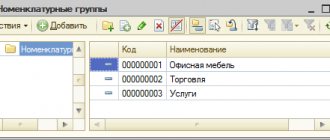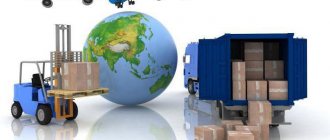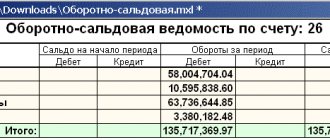What about materials?
In the process of working towards making a profit, business entities are often faced with the need to purchase related materials.
This type of property is of low value and is rarely purchased for the purpose of further resale. Inventory inventories (MPI) are used for production or management needs. The procedure for accounting and movement of materials must be reflected in the accounting policy of the enterprise, which each business entity has the right to form independently, without violating the requirements of current legislation. The rules for using information on materials are regulated by PBU 5/01 “Accounting for inventories”, approved by order of the Ministry of Finance of the Russian Federation dated 06/09/2001 No. 44n.
Important! From 01/01/2021 PBU 5/01 loses force, and the accounting rules are regulated by the new FSBU 5/2019 “Inventories”. Some accounting rules have been changed significantly. A ready-made solution from ConsultantPlus will help you rebuild your materials accounting. Get trial access to K+ for free and proceed to the material.
Also, on the basis of PBU 6/01 “Accounting for fixed assets”, approved by order of the Ministry of Finance of the Russian Federation dated March 30, 2001 No. 26n, equipment whose cost does not exceed 40 thousand rubles is included in the inventory.
Read about the nuances of accounting for assets whose value is below 100,000 rubles here.
What types of materials are there?
In accounting, materials, according to the Chart of Accounts (approved by order of the Ministry of Finance of the Russian Federation dated October 31, 2000 No. 94n), are accounted for on account 10 “Materials”.
Materials have a diverse grouping according to purpose and nature of use. Depending on these conditions, the organization’s materials are grouped into the following subaccounts.
| Subaccount designation | Subaccount name | What is taken into account |
| 10.1 | "Raw materials" | Inventories included in manufactured products that are involved in the manufacturing and processing process |
| 10.2 | "Components, purchased semi-finished products" | Materials purchased for further packaging of manufactured products |
| 10.3 | "Fuel" | Movement of fuel, including gasoline and diesel, as well as lubricants necessary during the operation of vehicles |
| 10.4 | "Container and packaging materials" | Availability and movement of all types of containers (except for those used as household equipment), as well as materials and parts intended for the manufacture of containers and their repair |
| 10.5 | "Spare parts" | Movement of materials used as spare parts for vehicles and other equipment |
| 10.6 | "Other materials" | Production waste, irreparable defects, material assets received from the disposal of fixed assets that cannot be used as materials, fuel or spare parts in a given organization (scrap metal, waste materials), worn tires, etc. |
| 10.7 | “Materials transferred for processing to third parties” | Materials transferred for processing to other companies |
| 10.8 | "Construction Materials" | Used by real estate developers. The invoice takes into account the materials needed for construction and installation work |
| 10.9 | "Inventory" | Inventory and other household supplies |
| 10.10 | "Special equipment and clothing in the warehouse" | Special equipment, uniforms, special uniforms in warehouse |
| 10.11 | “Special equipment and clothing in use” | Special equipment, uniforms, special uniforms handed over to employees for use |
Transfer to units
The transfer of materials to departments can occur without indicating the purpose of their expenditure (at the time of release from the warehouse, the name of the order (product, product) for the manufacture of which the materials are released or the name of the costs is unknown). In this case, write them off as expenses based on the act, which is drawn up after the actual use of the materials. Before the act is signed, these materials are listed as the recipient's account. The issue of materials is accounted for as an internal movement (documented by posting to subaccounts within account 10). Such rules are established by paragraphs 97 and 98 of the Methodological Instructions, approved by Order of the Ministry of Finance of Russia dated December 28, 2001 No. 119n.
An example of reflecting in accounting the write-off of materials when they are transferred to departments without indicating the purpose of their use
JSC "Alfa" produces blank parts from sheet metal. 100 sheets were transferred from the warehouse to the workshop (price - 50 rubles per sheet) without indicating the purpose of use (the corresponding columns of the requirement-invoice in form No. M-11 were not filled out).
These transactions were reflected in accounting as follows:
Debit 10 sub-account “Workshop” Credit 10 sub-account “Warehouse” – 5,000 rubles. (50 rubles/pcs. × 100 pcs.) – materials were transferred to the workshop without indicating the purpose of expenditure on the basis of the invoice requirement M-11.
After using the materials, a statement of their consumption was drawn up, indicating the types of workpieces for the production of which the metal was used. Based on the materials consumption report, the accountant made the following entry:
Debit 20 Credit 10 subaccount “Workshop” – 5000 rub. (50 rub./piece × 100 pieces) – materials are written off as expenses based on the materials consumption report.
Materials accounting
In order to control the availability and movement of inventories, a business entity can use both unified forms approved by Decree of the State Statistics Committee of the Russian Federation dated July 30, 1997 No. 71a, and those developed independently, taking into account the requirements for the mandatory details of the primary document (Article 9 of the Law “On Accounting” dated 06.12. 2011 No. 402-FZ) and enshrined in the company’s accounting policies.
Among the unified forms, the most popular are the following:
- demand-invoice;
- invoice for the release of materials to the third party;
- receipt order;
- limit fence card.
Materials are capitalized at the actual cost recorded in the documentation upon receipt. Inventory in an organization is accounted for either at its actual cost of receipt or at accounting prices, which must be enshrined in the accounting policy. When using the 2nd option, you should use account 16 “Deviation in the cost of material assets” and account 15 “Procurement and acquisition of material assets” to reflect the difference between the accounting and actual costs.
Example 1
Retro LLC has enshrined in its accounting policy the need to accept materials at discount prices. A batch of raw materials (granulated sugar) was received for further use in production in the amount of 100 kg for the amount of 4,000 rubles. Accepted accounting (planned) prices for this item are 45 rubles. for 1 kg. The following postings have been made:
| Debit | Credit | Amount, rub. | Contents of operation |
| 15 | 60 | 4 000 | The receipt of raw materials (granulated sugar) from the supplier was capitalized |
| 19 | 60 | 800 | Input VAT included |
| 10.1 | 15 | 4 500 | Accepted raw materials at discount prices |
| 15 | 16 | 500 | The excess of the book value over the actual value is written off |
If the accounting price were less than the actual cost, then the last entry would have the following form:
Dt 16 Kt 15. – the difference in the excess of the cost of goods over the accounting prices is written off.
Example 2
LLC "Raduga" upon receipt of materials capitalizes them at actual cost. When purchasing office supplies (20 pencils for a total of 1,000 rubles), the following entries were made for administrative needs:
| Debit | Credit | Amount, rub. | Contents of operation |
| 10.6 | 60 | 1 000 | Stationery purchased from supplier |
| 19 | 60 | 200 | Input VAT included |
| 26 | 10.6 | 1 000 | Stationery supplies were transferred upon request-invoice for the needs of the administrative apparatus |
After receipt, the materials are written off for production or other general business needs using one of the existing methods, which also must be reflected in the accounting policy:
- By average cost - when writing off, the average price of 1 unit of homogeneous material is formed.
- At the cost of each unit - suitable for a small group of inventories in cases where it is possible to form the cost of each unit.
- Using the FIFO method - this method allows you to take into account the cost of the first received materials in expenses (clause 16 of PBU 5/01).
Find out how to write off materials according to the new FSBU 5/2019 from the Guide from ConsultantPlus by getting free trial access to the system.
Carrying out an inventory of goods and materials
Inventory of inventory is a procedure that is periodically carried out at each enterprise and helps maintain order in accounting. During the inventory process, the actual presence of valuables at the enterprise is checked and compared with the accounting data.
The frequency of inventory is at least once at the end of the year. Also, the procedure can be carried out throughout the year if necessary, for example, during a control check or changing the person responsible for storing inventory items.
During the inventory, unusable materials are identified that are subject to further write-off.
The procedure for inventory inventory
The procedure for reconciling actual and accounting data is entrusted to a commission appointed by management. The commission usually includes financially responsible persons, accounting employees and representatives of the management team of the enterprise. The chairman of the commission is appointed as the head. The commission’s tasks include monitoring and organizing the inventory and proper documentation.
Documentation of inventory of goods and materials
First of all, the manager approves the inventory order. The text of the order specifies which values are subject to recalculation and reconciliation with accounting data, approves the composition of the inventory commission, and also sets the deadline for the procedure.
When checking and recounting materials, inventory lists are drawn up, in which a sequential list of all recalculated property is provided, indicating the name, article, actual quantity and other necessary indicators.
To account for materials stored in the warehouse, an inventory list of inventory items INV-3 is filled out.
In addition to the fact that you need to recalculate inventory items in the enterprise’s warehouse, you also need to take into account those materials that are not currently in the warehouse, but still belong to the enterprise.
These include:
- Inventory transferred for safekeeping to other organizations
- Inventory items that are in transit (that is, purchased from other enterprises, but have not yet reached the warehouse)
- Valuables sold and shipped from the warehouse for which payment has not yet been received from the buyer
- Valuables transferred for processing to other organizations
To account for these inventory items, fill out the following forms:
- INV-4 “Inventory report of shipped goods and materials”
- INV-5 “Inventory list of goods and materials accepted for safekeeping”
- INV-6 “Act of inventory of payments for inventory items in transit”
Information in these inventories and acts is entered on the basis of documents confirming the fact of transfer to custody, shipment to customers, purchase and payment from the supplier.
Upon completion of the inventory procedure, discrepancies between accounting data and actual data are identified, which are reflected in the matching sheet INV-19.
All this data is transferred to the accounting department. The accountant carries out the necessary actions and reflects the postings for capitalizing surpluses and writing off shortages.
Accounting for inventory results
Accounting for surplus:
Surpluses are inventory items that are actually available, but are not documented in any way.
Surplus inventory items are recognized as other income and are reflected in the credit of account 91. The surplus is credited to the debit of the materials accounting account (account 10).
The posting for accounting for surplus has the form: D10 K91.1.
Accounting for shortages:
Shortage of goods and materials are values that are listed at the enterprise according to documents, but are actually missing.
The shortfall must be written off to the credit of the materials account.
To account for shortages, account 94 “Shortages and losses from damage to valuables” is used.
The posting to reflect the shortage identified during the inventory process has the form D94 K10.
Within the limits of the norms, the shortage can be written off as a debit to production cost accounts. Wiring: D20 (23) K94.
If the culprit is identified, then the shortage is written off by posting D73.2 K94. Then the guilty person can independently deposit the amount of the shortage into the cash desk of the enterprise D50 K73.2, or the amount can be withheld from his salary D70 K73.2.
If the culprit is not identified, then the amount of shortage of materials is written off as other expenses using posting D91.2 K94.
Postings for material inventory:
| Debit | Credit | the name of the operation |
| Accounting for surplus | ||
| 10 | 91.1 | Excess materials are taken into account as other income |
| Accounting for shortages | ||
| 94 | 10 | The shortage of materials identified during the inventory was written off |
| 20 (23) | 94 | Shortage of materials within normal limits written off |
| 73.2 | 94 | The shortage of inventory items was written off to the account of the perpetrators |
| 50 | 73.2 | The guilty person reimbursed the amount of the shortfall in cash to the cash register |
| 70 | 73.2 | The amount of the shortfall is withheld from the salary of the guilty person |
| 91/2 | 94 | The shortfall was written off as other expenses due to an unidentified culprit |
Postings for receipt and disposal of materials
There are several ways for materials to enter an organization: acquisition for a fee, acceptance as a contribution from the founders, production of materials, free receipt, etc.
Depending on the method of receipt, the following postings for materials appear in accounting.
| Debit | Credit | Contents of operation |
| 10 | 60, 76 | Receipt of the invoice from the supplier; Wholesale supply of goods is carried out under a sales contract |
| 10 | 71 | Acquisition of inventories by an accountable person |
| 10 | 75 | Founder's contribution; the estimated value of the property must be agreed upon with the person contributing the property |
| 10 | 91 | Reflected gratuitous receipt; In this case, the market value of the material is taken as the amount. A similar posting is made when taking into account materials received during the dismantling of fixed assets |
If upon receipt the cost of the material includes VAT, then its amount is reflected in a separate line.
Example 3
Motiv LLC purchased a batch of paper (100 packs) for office needs using an invoice for a total amount of 18,000 rubles, including VAT 20% of 3,000 rubles. The organization made the following entries:
| Debit | Credit | Amount, rub. | Contents of operation |
| 10.6 | 60 | 15 000 | A batch of paper has arrived |
| 19.3 | 60 | 3 000 | The amount of input VAT is reflected |
| 68.2 | 19.3 | 3 000 | VAT amount accepted for refund |
| 60 | 51 | 18 800 | Payment was made to the supplier through a bank account |
For more information on the formation of VAT when purchasing inventories, see the material “How is VAT recorded on purchased assets?” .
If an organization applies a taxation regime that excludes the use of VAT (STS, UTII), then the entire cost of materials should be credited to account 10. In this case, VAT does not apply to refundable taxes, but is taken into account when determining the cost price.
The release of inventories to third parties can be carried out for the following number of reasons:
| Debit | Credit | Contents of operation |
| 20, 23, 25, 26, 29, 44 | 10 | Issue from a warehouse for production or general business needs of the organization; transfer is carried out using limit-fence cards or requirements-invoices |
| 94 | 10 | The gratuitous write-off of materials as a result of damage or theft is reflected. As a rule, a lack of food supplies is identified as a result of an inventory; an act of write-off of materials is drawn up |
| 99 | 10 | The materials were lost due to a natural disaster; the transaction is reflected using a write-off statement |
| 91 | 10 | Reflection of the transfer (sale) of materials to the third party; actual cost is used |
Sale of MPZ
The sale of mats is carried out at the amount agreed upon between the seller and the buyer. The calculation and payment of taxes on the sale of materials is regulated by law. When selling inventories, an invoice must be issued for the consumption of material on the side, an agreement and an invoice must be drawn up. If materials are transported through a third-party organization, a consignment note must be issued. Documents for transactions related to the sale of inventories: invoice M-15, invoice, bank statement (hereinafter referred to as BV), payment order (hereinafter referred to as PP), accounting statement, sales book, purchase book.
Results
Any movement of inventories must be documented in primary documents and recorded in accounting entries.
The primary report can be compiled using standardized forms or on forms developed by the business entity independently. Postings are compiled in accordance with the Chart of Accounts. The cost of materials and the rules for their acceptance for accounting, as well as movement or disposal before 01/01/2021 are determined in accordance with PBU 5/01, and from 01/01/2021 the new FSBU 5/2019 “Inventories”. You can find more complete information on the topic in ConsultantPlus. Free trial access to the system for 2 days.
Taxes
For information on how to reflect the disposal of materials for income tax purposes, see What material expenses should be taken into account when calculating income tax.
For information on how to reflect the write-off of the cost of materials upon transfer to operation (production) by an organization in a simplified manner, see How to write off material costs using the simplified tax system.
If an organization pays UTII, writing off materials will not affect the calculation of this tax. Payers of UTII calculate this tax based on imputed income (clause 1 of Article 346.29 of the Tax Code of the Russian Federation).
For information on how to reflect the write-off of the cost of materials upon transfer to operation (production) by an organization that applies the general taxation system and pays UTII, see How to take into account expenses for income tax when combining OSNO with UTII.








